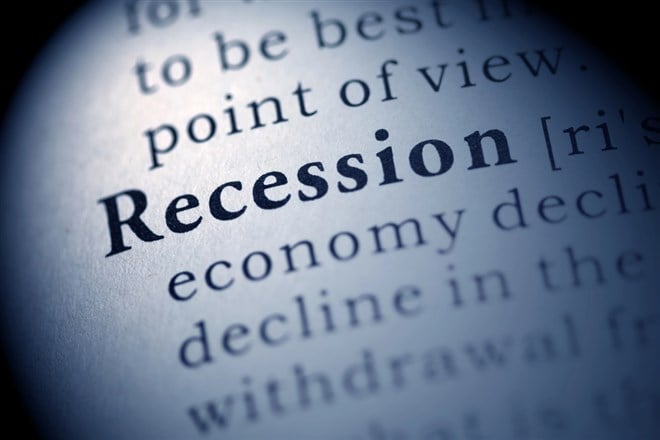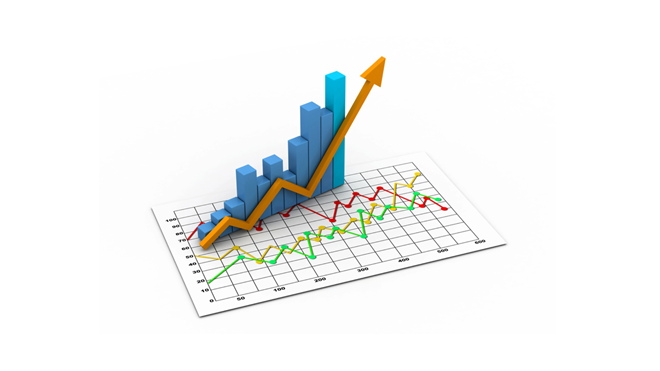Ticker Reports for November 18th
3 Smart Defensive Stocks for an Uneasy Market
At one point in early November, the Dow Jones Industrial Average (DJIA) briefly topped 48,000 for the first time ever. At different times in 2025, the NASDAQ and S&P 500 have made new all-time highs (ATHs). Despite sharp price swings, it's been a solid year to own stocks.
Yet many economists, analysts, and investors remain uneasy. The market appears priced for perfection—but recession risks are not priced in.
Even with broad gains, some skepticism persists. The Magnificent 7 trade may have cooled off, but the market is clearly being lifted by a narrow group of names, mostly tied to the AI boom.
The K-Shaped Economy Concern
Current economic commentary focuses on a K-shaped recovery. Higher-income consumers are navigating inflation of around 3%—still above the Federal Reserve’s informal 2% target but manageable for affluent households.
But lower-income consumers have been under pressure for several years. There’s increasing evidence in credit defaults, delinquent auto loans, and more recently, an uptick in foreclosures, which suggests this problem is getting worse. The labor market had been the economy’s strongest pillar, but even that is starting to show signs of strain.
JPMorgan Chase & Co. (NYSE: JPM) recently lowered its estimation of the probability of a recession from 60% to 40%, due to the recent de-escalation of trade tensions. But that’s still a significant risk.
Market Breadth Remains Narrow as Investors Chase Mega-Caps
Recent data from Charles Schwab shows the percentage of S&P 500, NASDAQ, and Russell 2000 stocks trading above their 200-day moving average was slightly above 50%. That’s historically low market breadth, which is adding to investors' concerns.
This isn’t a redux of 2021, when investors piled into unprofitable SPACs in hopes of becoming a millionaire. In many cases, the market froth is coming from mega-cap stocks that have plenty of cash on the balance sheet. Still, investors have a sense that many of these stocks are simply overvalued.
So what’s an investor to do? Here are three stocks that provide the opportunity for an asymmetric return in the current uneasy market.
Procter & Gamble Has More Than a Dividend to Like
Procter & Gamble Co. (NYSE: PG) is part of the exclusive Dividend Kings club, meaning the company has increased its dividend for at least 50 consecutive years—70 years in the case of PG, which is why it’s a staple in the portfolio of many income-oriented investors.
The 2.8% dividend yield could look even better if rates fall. Plus, 2025 brings potential growth—the $171.53 price target implies 17% upside.
It's unclear how the company’s proposed acquisition of Kenvue (NYSE: KVUE) would impact the company’s earnings.
However, if the deal goes through and the Tylenol controversy abates, there would almost certainly be a small earnings per share (EPS) dilution in the first year.
After that, the dilution would likely turn into a boost in EPS due to cost synergies with the two companies.
Johnson & Johnson Doubles Down on Medtech and Oncology Growth
The next company on this list is Johnson & Johnson (NYSE: JNJ), the company that spun off Kenvue in 2023 with the intent to lean into its medtech and pharmaceutical businesses.
Its recent $3.5 billion acquisition of Haida Therapeutics is one example of the new company’s plans.
The all-cash deal gives JNJ access to the clinical-stage company’s HLD-0915 drug candidate.
This is a once-daily oral prostate cancer medication that received fast-track designation from the U.S Food & Drug Administration (FDA).
This will be a material addition to the company's oncology pipeline, which should make JNJ stock more appealing to growth-oriented investors.
The DIA ETF Could Benefit From a Flight to Safety
Over the past five years, many investors embraced a passive "SPY and chill" strategy, meaning investing in the SPDR S&P 500 ETF Trust (NYSEARCA: SPY).
The SPY may still be a good investment, but with potential AI overexuberance, it may also be time to consider the SPDR Dow Jones Industrial Average ETF Trust (NYSEARCA: DIA).
If concerns over an AI bubble take hold, there is likely to be a strong rotation into stocks that make up the Dow 30. That would make the DIA ETF a solid asymmetric investment to capture this rotation play.
As of this writing, the DIA ETF has only about 37% institutional ownership. However, it’s seen more buying than selling in seven of the last eight quarters, hinting that institutions are beginning to build a hedge against a possible slowdown in the tech trade.
These 3 Stocks Are Using Buybacks to Signal Market Confidence
Several key stocks are making notable buyback announcements. Below, we examine the latest moves by Trade Desk, Thermo Fisher, and Tapestry—and what they reveal about each company's capital return strategy.
Trade Desk Ups Buybacks by $500 Million, But Spending Pace Could Slow
First up is Trade Desk (NASDAQ: TTD). This stock has endured a brutal year, with shares down 64% after the company's Q3 earnings report resulted in a nearly 39% fall on Aug. 8. Slowing growth and concerns about competition from Amazon.com (NASDAQ: AMZN) have led to worries that Trade Desk is losing its competitive position.
On its Q3 earnings call, the company announced the approval of a $500 million repurchase authorization, 2.5% of the firm’s market capitalization.
This figure is relatively modest, considering the company spent around $1.14 billion on buybacks last year. Thus, if used over the next 12 months, the $500 million program would represent a significant deceleration in the firm’s buyback pace.
With the stock trading at its lowest point in over three years, investors may have expected a more aggressive repurchase commitment.
Still, the company could use its current authorization quickly and announce a new one shortly thereafter. The pace at which this authorization is deployed will offer insight into management's confidence in Trade Desk's potential for a turnaround.
Thermo Fisher: Opportunistic Repurchaser Adds $5 Billion Authorization
Thermo Fisher Scientific (NYSE: TMO) is the world’s most valuable stock in the life sciences and tools industry. Shares have notched an approximately 12% total return in 2025.
The company’s Q3 2025 earnings results were strong, beating estimates on both sales and earnings per share.
The market also reacted very positively to Thermo’s deal with Vaxcyte (NASDAQ: PCVX), where the latter secured space in Thermo’s North Carolina manufacturing facility, committing up to $1 billion.
This news sent Thermo shares up by 5% on Sept. 30, and another 9% on Oct. 1.
On Nov. 6, the company announced a $5 billion repurchase authorization, equal to about 2.3% of the firm’s approximately $218 billion market capitalization.
The new authorization allows Thermo to maintain a strong repurchase pace if it chooses. The company spent $1 billion on buybacks last quarter and has allocated $3 billion to repurchases so far in 2025—even after skipping buybacks entirely in Q2.
Thermo’s approach is typically opportunistic rather than consistent, with large buybacks in some quarters and none in others. It tends to repurchase shares when the stock price dips significantly, aiming to enhance shareholder value by timing its purchases strategically.
Tapestry Looks to Return 100% of Cash Flow to Shareholders
Last up is consumer discretionary stock Tapestry (NYSE: TPR). Tapestry owns a variety of luxury brands, including Coach and Kate Spade. The stock has had an impressive year, delivering a total return of 57%. Coach, which accounted for around 84% of total revenue last quarter, has continued to drive the company’s success.
While the company didn’t increase its repurchase authorization, it revised its fiscal year 2026 buyback target upward to $1 billion, up from its previous projection of $800 million.
This would represent approximately 4.8% of the firm’s market capitalization, with half of this spending yet to be incurred.
Tapestry has been returning capital to shareholders hand over fist.
It spent over $2.8 billion on buybacks over the last 12 months, delivering a 12.6% buyback yield.
Add in its 1.6% dividend yield, and the company’s goal to return 100% of free cash flow to shareholders in FY2026 is a significant commitment to capital returns.
TTD, TMO, TRP Offer Different Approaches to Buybacks
The buyback announcements and capital return policies of Trade Desk, Thermo Fisher, and Tapestry are all intriguing. With shares down so massively, it would be an encouraging sign for Trade Desk to use its newfound buybacks quickly. Thermo Fisher’s practice of reserving buybacks for periods when shares are down has the potential to add considerable value for shareholders. Meanwhile, Tapestry’s aggressive shareholder return plan underscores confidence in its core business and financial health.
As each company moves forward, the execution and pacing of buybacks will be a telling indicator of management priorities and long-term strategic thinking.
Refund From 1933: Trump's Reset May Create Instant Wealth
Refund From 1933: Trump's Reset May Create Instant Wealth
3 Companies to Watch as Natural Gas Stocks Make a Comeback
Don’t look now, but energy stocks are starting to look like compelling investments once again. While crude oil prices have been under pressure, natural gas prices are up over 70% year-over-year—and over 50% in the last three months.
Several catalysts are driving this rally. First, the United States had an early blast of winter weather, driving seasonal heating demand. Second, liquefied natural gas (LNG) exports to Europe remain strong amid ongoing concerns that Russia may cut supply. Third, and most notably, the artificial intelligence (AI) buildout is providing a tailwind for energy prices for years to come.
This benefits natural gas producers who continued drilling even when prices were lower. Their improved balance sheets and production outlooks make them well-positioned heading into 2026. Below are three natural gas stocks to consider as this trend unfolds.
America’s Largest Gas Producer Is Positioned for a Big Run
Expand Energy Corp. (NASDAQ: EXE) may not be a household name to investors, but it stands to be one of the largest beneficiaries of the rising demand for natural gas. EXE stock is up 17.8% year-to-date (YTD) and is on pace to match its 12-month growth of around 23% and its five-year total return of over 267%.
The company was formed after the merger between Chesapeake Energy and Southwestern Energy and is currently the largest natural gas producer in the United States.
Investors who recall that Chesapeake went through bankruptcy may be cautious about investing in EXE stock. However, Expand Energy has shown improved operational efficiency.
The company expects to achieve $500 million in annual synergies this year and about $600 million next year. That’s expected to boost free cash flow by 30% this year and 20% in 2026.
Supporting the bullish argument, Expand Energy's revenue is up 358% year-over-year (YOY) through the first three quarters of 2025.
Investors may also look sideways at an energy stock with a price-to-earnings (P/E) ratio of 33x—higher than typical energy peers—however, the more important metric may be the whopping 312% earnings growth that analysts are forecasting.
Permian Exposure and Data Center Demand Drive Upside
Diamondback Energy Inc. (NASDAQ: FANG) has lagged the market in 2025, https://www.marketbeat.com/stocks/NASDAQ/FANG/chart/ YTD. However, with a consensus price target of $188.55, analysts see upside of more than 27% from current levels.
The stock has started to recover, rising about 3.8% in the last month following its solid earnings report in which revenue beat estimates by over 11% and earnings per share (EPS) beat by 4.7%.
Reasons to be bullish about Diamondback Energy include its exposure to the Permian Basin and its involvement in the Competitive Power Ventures project, where it has agreed to supply 50 million cubic feet per day to a major 1,350-megawatt power plant.
It is also targeting long-term contracts to fuel data center expansion, a growing demand source for natural gas.
Diamondback Energy continues to prioritize free cash flow growth per share over production growth. As evidence of this, in the company’s Q3 earnings report, it reported a 36% reinvestment rate year-to-date, assuming oil prices in the mid-$60s, underscoring its capital discipline and focus on shareholder returns.
A Beaten-Down Midstream Giant That May Be Oversold
ONEOK Inc. (NYSE: OKE) presents a more conservative, midstream angle on the natural gas rally. OKE stock is down 30% in 2025, but analysts are bullish, with a consensus stock price of $89.27 offering potential upside of more than 28%.
ONEOK has delivered strong revenue growth in 2025, but investor concerns about the company’s high projected capital expenditures for the current year have weighed on sentiment.
Even though the company is forecasting that level of expense to move lower in the future, some fear it could impact short-term earnings.
However, this stock may now be beaten down to the point of being attractive, particularly with crude oil prices expected to rise in the next 12 to 18 months. With a strong earnings beat and natural gas infrastructure in high demand, OKE stock may represent an oversold opportunity in a rebounding sector.
Everyone's watching Nvidia right now. Here's why I'm excited.
Everyone's watching Nvidia right now. Here's why I'm excited.






